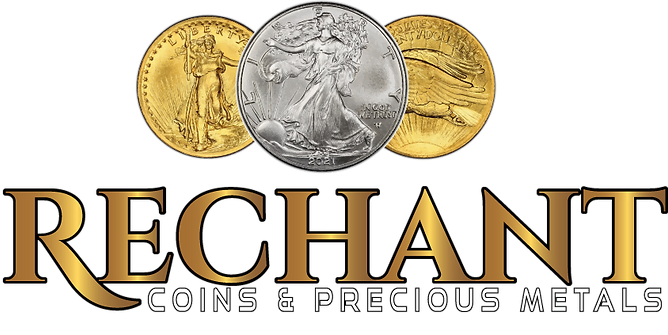ANA Numismatic Grading Standards Novice Coin Grade Guide
Diving into the world of numismatics unlocks a fascinating realm where history and value intersect, offering collectors a unique blend of enjoyment and investment potential. The key to thriving in this hobby involves not just acquiring pieces of history but understanding their condition through a precise lens.
Rechant Coins & Precious Metals, a stalwart in the West Palm Beach, Florida community since 1975, exemplifies the pinnacle of excellence in providing collectors with superior collectible coins and bullion.
Their dedication to quality aligns with the American Numismatic Association's (ANA) grading standards, which serve as the gold standard in evaluating a coin's condition. Adhering to these grading standards ensures that collectors are equipped with the knowledge to discern the quality of their coins.
Understanding Numismatic Grading Standards
The market value of a coin significantly hinges on its condition, highlighting the importance of a systematic approach to grading in coin collecting. This methodical evaluation not only hinges on simple observations but has transformed into a multifaceted system governed by strict standards.
Among the most recognized is the Sheldon Scale, celebrated for its precise numeric grading that throws light on the fine distinctions in a coin's condition.
Professional grading services such as PCGS have further refined the grading landscape by establishing standardized criteria for assessing a coin's wear, luster, and eye appeal.
These components are essential for an accurate analysis, offering special designations for coins that showcase exceptional features like full steps or pronounced cameo contrasts. Such meticulous grading paves the way for the nuanced understanding necessary in the intricate world of numismatics. Grasping the nuances of the grading scale, particularly the Sheldon Scale, proves essential for evaluating United States coins, taking into account factors like luster, eye appeal, rim condition, PCGS classifications, hairline imperfections, mint state, and whether the coin is uncirculated, which all influence a coin's value and appeal in coin collecting.
Exploring Coin Grades
The assessment of a coin's market value is heavily reliant on its physical state, highlighting the importance of familiarizing oneself with grading scales. This knowledge is crucial for anyone involved in the numismatic field, whether for passion or profit.
The grading system, with its 70-point scale, is a cornerstone of this evaluation, where higher numbers are synonymous with superior conditions.
This methodology is key in pinpointing a coin's worth, a vital skill for transactions in the numismatic world.
A coin with a high-grade exhibits exceptional eye appeal, often characterized by mint luster indicative of minimal circulation. Such coins, scoring 60 or above on the grading scale, show no trace of wear, thus preserving their intricate designs and details.
On the opposite end, grades below 15 unveil coins with noticeable wear, diminishing their attractiveness and monetary value. Mastery of these grading nuances is indispensable for accurately evaluating coins, where aspects like mint luster, trace of wear, planchet quality, achieving a higher grade, attention to the highest points, exceptional eye appeal, identifying counterfeits, conditions such as extremely fine or slight wear, and affiliations with grading organizations like NGC and ANA, play critical roles in their valuation.
Key Insights on Coin Grading
- Coins graded 70 are considered perfect, with no post-production imperfections under 5x magnification.
- The Sheldon Scale, ranging from 1 to 70, was developed in 1949 and is now the standard for grading U. S. coins.
- A coin's grade can significantly affect its market value, with higher grades often commanding exponentially higher prices.
- Professional grading services like NGC and PCGS also assess authenticity, further safeguarding a coin's value.
ANA Grading Standards Explained
Unlocking the mysteries behind the American Numismatic Association (ANA) grading standards enhances one’s appreciation and understanding of numismatics. The journey from broad, subjective descriptions to the precise, detailed classifications we rely on today charts a fascinating evolution in how we assess and value coins.
At the heart of this revolution stands the ANA, instrumental in crafting a grading language that resonates across borders.
Central to this grading language is the 70-point Sheldon Scale, a meticulous framework that distinguishes coins with remarkable clarity.
From the Basal state (1), where coins are just identifiable, to the pristine Perfect Mint State (70), devoid of any imperfections, this scale is the cornerstone of grading standards for United States coins. Mastery of this scale is vital for anyone keen on discerning the subtle nuances between adjacent grades. Evaluators draw upon a comprehensive set of criteria, including ANA grading standards, contact marks, grading standards for United States coins, the official American Numismatic Association grading scale, third-party grading services, the condition of coins, preservation of original luster, and the presentation of coins at shows.
Coin Grading Services Overview
Understanding the nuances of a coin's condition plays a pivotal role in its valuation and appeal to collectors. This critical assessment, through the lens of established grading of coins, ensures buyers and sellers can engage with confidence.
The process involves a meticulous evaluation using terminology and standards for mint-state and circulated pieces, reflecting their preservation and aesthetic qualities.
The transition to formalized grading systems, such as the Sheldon Scale, marked a significant evolution in numismatic practices.
The American Numismatic Association's official grading guidelines have been instrumental in bringing consistency and clarity to the assessment process. By adhering to these official grading terminology and standards, stakeholders in the numismatic community can make more informed decisions.
Leading the charge in this field are several reputable services, each grounded in distinct principles and employing rigorous standards for coin grading systems. These entities provide essential evaluations, attributing grades that communicate a coin's state accurately, employing the American Numismatic Association’s official grading terminology and standards, including the Sheldon scale and other coin grading systems, to assess everything from mint-state to circulated conditions, noting specific details such as luster and center detail to determine if a coin's appearance might suggest a higher grade.
| Grading Scale | Importance in Numismatics | Examples of Grading Services |
|---|---|---|
| Sheldon Scale | Brings consistency and clarity | PCGS |
| ANA Official Guidelines | Instrumental for standardized assessment | NGC |
| Mint-State to Circulated Conditions | Reflects preservation and aesthetic qualities | ANACS |
Decoding Ngc And Pcgs Grading
Understanding the meticulous process by which third-party grading services like NGC and PCGS determine the value of collectible coins opens up a new dimension in numismatics. These organizations use a comprehensive scale from 1 to 70, making it essential for each coin graded, especially those minted since 1793, to meet certain standards of condition and appeal.
This grading system plays a pivotal role in establishing a coin's market value, making it integral for collectors to comprehend.
The coin grading process starts with a thorough examination to ascertain a coin's placement on the scale, which can greatly influence its worth.
For a coin to achieve a high grade, it must not only exhibit an attractive sharp strike and full original luster for the date and mint but also possess certain qualities that make it stand out. NGC prioritizes these aspects, offering special designations like Full Bands and Full Bell Lines to coins with an attractive sharp strike and full original luster, reflecting the highest standards in the coin grading process for coins minted since.
Mastering Mint State Grading
The craft of distinguishing the finest details on uncirculated coins represents a pinnacle of numismatic expertise, where the quality of luster and the precision of the strike for date and mint play critical roles. This skill set is not only about preserving history but also about understanding the nuances that significantly influence a coin's market value.
As every coin tells a story, the challenge lies in accurately interpreting its condition to ensure its narrative remains authentic and its valuation precise.
Grading scales that range from poor to perfect serve as the backbone of coin evaluation, with each grade offering a snapshot of the coin's journey through time.
Coins with full original color and luster occupy the highest echelons of this scale, reflecting their pristine state and untouched beauty. For instance, Franklin half dollars can reveal remarkable details if the entire design is bold and the surface shines bright with full original color, embodying the highest quality of luster that distinguishes mint-state coins from circulated ones, making those U. S. coins with this feature sought after by collectors, sometimes fetching prices 70 times their face value, especially when the strike for date and mint is sharply defined.
Key Insights on Numismatic Expertise and Coin Grading
- The condition of a coin, including its luster and the precision of its strike, significantly impacts its market value.
- Coins that maintain their full original color and luster are considered to be in the highest state of preservation, commanding higher prices.
- Franklin half dollars with full original color and a sharp strike can fetch prices significantly higher than their face value, sometimes up to 70 times more.
- Grading scales help in determining the precise value of a coin by categorizing its condition from poor to perfect.
Coin Grading Terminology Demystified
Unlocking the secrets contained in the fine details of numismatic grading, one discovers the key to appreciating and accurately valuing a coin collection. This process involves a meticulous examination where flaws may be present, yet each detail contributes to the story and value of the piece.
Introduction to the Basics: At the heart of numismatic appreciation, the grading system functions as the critical framework defining the collective understanding between buyers and sellers.
Acknowledging the crucial role of this evaluation system allows one to explore the depths of coin collecting with a knowledgeable eye, where even light hairlines may show but do not detract from a coin’s allure.
Breaking Down the Grades: Spanning from grades indicating considerable wear to those reflecting pristine condition, the grading scale provides a comprehensive method to gauge a coin's physical state. Visual aids enhance this classification, enabling enthusiasts to discern subtle differences; a few small single hairlines may show, flaws may be present, light hairlines may appear, resulting in a piece that is average and very pleasing, pleasing for the date, with an adequate strike for the date, small scattered contact marks, an original or darkened color, surfaces that may be slightly dull, and numerous small contact marks.
Evaluating Eye Appeal And Luster
When assessing the value of a coin, its visual allure, particularly the absence of scattered heavy marks and the presence of an intact mint luster, can significantly influence its market worth. This allure stems not only from the coin's design but also from its condition, including the color, tone, and minimal distracting imperfections.
To accurately gauge these qualities, one must understand how diminished color and tone can impact a coin's appeal and how mint luster may mark a piece as highly desirable.
In the intricate task of evaluating a coin, the lighting used plays a pivotal role; it should be sufficient but not so direct as to cast shadows or create glare.
These conditions can either mask flaws like planchet defects may show or exaggerate the coin's shine, misleading its true quality. Employing a magnifying tool is essential in identifying subtle details, such as a heavy concentration of hairlines.
PCGS Coin Price Guide Reveals Rare US Coin Values
Uncirculated Coin Sets Trusted Dealer Showcasing Rare Silver Dollars










